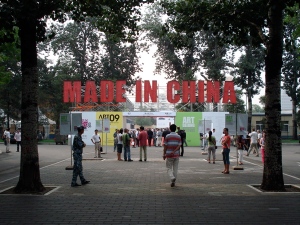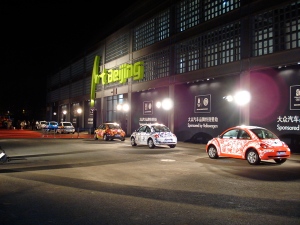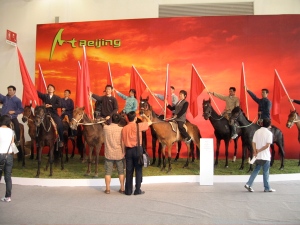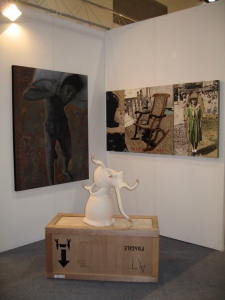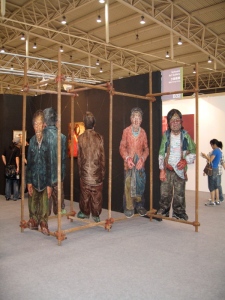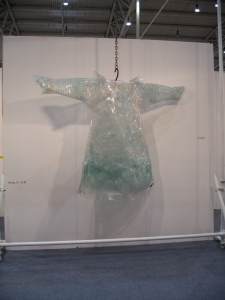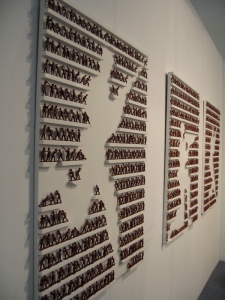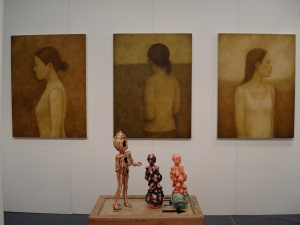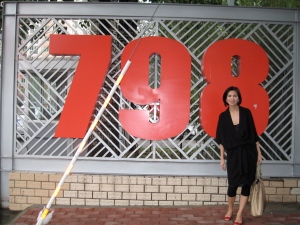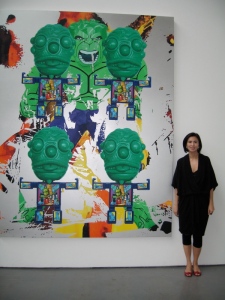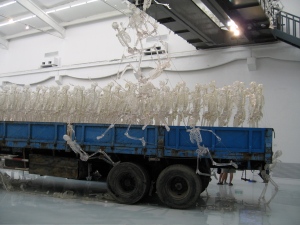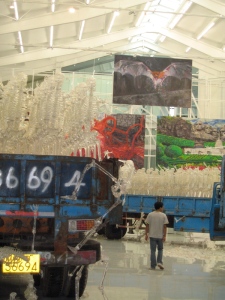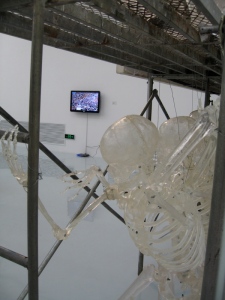Possessed of airline miles that had to be redeemed before the month was out, I conceived the idea of flying to Beijing after all the Olympic hoopla had settled. My friend, Dindin Araneta of Art Cabinet Philippines, signed up to participate in Art Beijing, from September 5 to 9, and I thought it would be interesting to tag along. Art, history, good friends, the perfect mix for a much-needed respite. I definitely got more than I bargained for, but Beijing did not disappoint.
From the moment we landed at the immense, majestic, dragon-shaped, brand new Terminal 3, I was programmed to be impressed. Whatever else television and a hastily chosen guide book in Hong Kong had to say about the city, I did not expect this ultra-modern, wide avenued, seemingly spotless metropolis. I prepared myself to enjoy its sights for the next seven days.
ART BEIJING
Much has been made of the triumph of the Chinese contemporary arts scene, and the commercial and iconic heights Chinese artists like Yue Minjun and Zhang Xiaogang have scaled. Art Beijing, founded by Dong Mengyang, sought to ride on this success, hoping to bring to Beijing
the international community of art collectors, dealers, and galleries that have made the Shanghai art fair an annual destination. While it is the Beijing art fair’s third year, it is still considered the “younger sister” of the other Chinese events. I would still recommend it to art lovers and other Pinoy art fair virgins like myself, whose typical exposure is still rooted to oil on canvas works. I thoroughly enjoyed the sculpture, installations, and video art on view.
Art Cabinet Philippines was the only Filipino participant, and for a day or two, things got a bit
hairy. Quarantine, so strict at this time because of the Paralympic Games happening at the same time, refused to release the crates from the Philippines. It took a whole day of negotiations before they agreed to let the cargo out, and another day to finally set up the booth in time for the fair’s VIP night. There went the day originally scheduled for traversing the Great Wall! But no matter, it was all in the service of Philippine art.
All that hard work was rewarded in the end, judging from the audience’s reaction to the Filipino work on display. The artists were Anton del Castillo, Ambie Abano, Albert Avellana, Jonathan Ching, Eugene Jarque, Lea Lim, Leeroy New, Erwin Catral Leano, Jose John Santos III, Pamela Yan Santos, Don Salubayba, Mac Valdezco, and Christopher Zamora. Anton del Castillo’s mixed media series, Pattern for Chaos, was definitely a huge draw, as was Mac Valdezco’s biomorphic forms made from cotton string. However, I can honestly say, without any biases, all the Filipino artists on display had their own share of fans.
For more information on Art Beijing and the Philippine art on view, visit www.artcabinetphilippines.com and www.artbeijing.net
798 ART DISTRICT
No art aficionado’s visit to Beijing will be complete without a day spent at the 798 District, a vast compound of old factories and warehouses that have been converted into galleries, bars, restaurants, and small shops. I only had half a day to spare on my last day in Beijing, and I had to limit myself to three shows: Pace Gallery’s Encounters with the contemporary art greats from their New York space, De Feng Art’s Robert Rauschenberg exhibit, and my favorite, Microscopic Narration: Social Images by Zhang Xiatao and Li Yifan at Iberia, the Spanish contemporary art space.
Pace Gallery had works by Jeff Koons, Chuck Close, Jean-Michel Basquiat, Warhol, Cindy Sherman, and other million dollar names that collectors in Beijing have started to acquire. More than just the show, the gallery itself, set up so that the space seems as if it floats in a pond of lillies, adds to the whole experience.
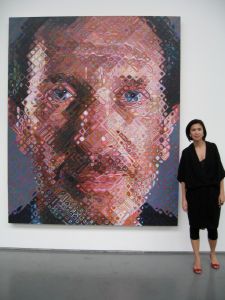
With a piece by Chuck Close
Da Feng Art is a small gallery in a far corner of the 798 complex. It is owned and run by William Isler, an American. Their show, the late Robert Rauschenberg’s Lotus Series of photocollages, poignantly reminds one of the Beijing of the 1980s, way before the government opened up and allowed the city to flourish into the supercity we see today.
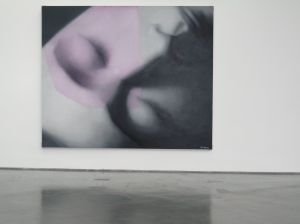
By Zhang Xiaogang
I stumbled onto the Iberia Center for Contemporary Arts as I made my way to the Robert Rauschenberg show. As I peeped inside, I couldn’t help but be drawn in by the sight of about a thousand clear fiberglass skeletons lined up on the rafters, piled atop two dump trucks, hanging from pulleys. This was the first portion of a two-man show by Chinese contemporary artists Zhang Xiatao and Li Yifan. The pictures just don’t capture the powerful scale of the installation, a commentary on the effects of social and environmental change in the name of progress.
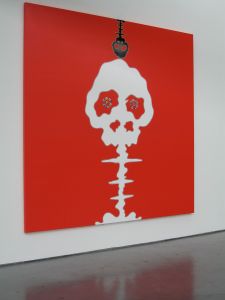
By Takashi Murakami
798 Art Zone is at Jiuxianqiao Road, Chaoyang District
DUCK DE CHINE AND THE YIN BAR THE EMPEROR HOTEL
If I needed further proof on how cosmopolitan life in Beijing can be, two restaurants I tried on consecutive nights certainly sealed the deal.
Duck de Chine is a series of charming brick pavilions burrowed beneath the high rise buildings in the Sanlitun shopping area. You enter through an art gallery that connects via a glass-enclosed passageway to the restaurant’s main dining area. There is also an outdoor bistro and the ubiquitous karaoke bar further inside one of the pavilions. But the main attraction of the place is their duck, roasted Peking or French style, either way so delicious, that we waited for 45 minutes for our table, despite having reservations.
I was with an ex-colleague now based in Beijing, so he knew not to order too many side dishes. Focus on the duck. We opted for the local version, and it arrived with a choice of wraps: the usual pancakes, or more traditional for Beijing, small round sesame buns. Superb!
The next night, I intruded on a client dinner of fellow art fair participants at the rooftop Yin Bar of the newly-opened Emperor Hotel. It was a bit of a drive from our hotel, but well worth the frustration of trying to communicate with the taxi driver. The hotel is part of the Design Hotels group of luxury boutique hotels. It is a retro, mod, marvel of neon brights and white walls, all of 55 rooms. They served us dinner in the open-air bar where we enjoyed a breathtaking view of the Forbidden City, gloriously lit up on that breezy evening. The food, served from the kitchen of the Shi restaurant on the second floor, was fusion, a modern take on traditional Chinese dishes. We had a sampling, all small portions, most made a bit too spicy for my taste. But the setting, incomparable.
Duck de Chine @ 1949 – The Hidden City is at Gong Ti Bel Lu, Chaoyang District
Yin Bar , The Emperor Hotel, is at 33 Qihelon St., Dongcheng District
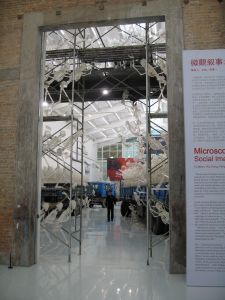
Entrance to Microscopic Narration exhibit

